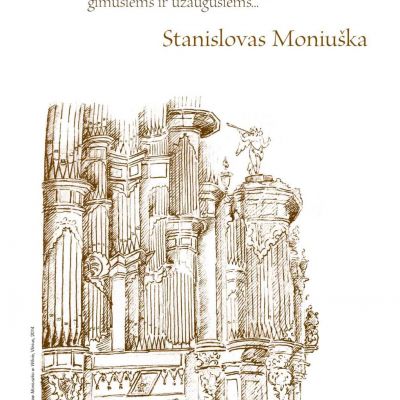Belarusian Images in the Concert-Chamber Art of S. Moniuszko

Assoc. Prof. Tatiana Tsybulskaya, head of the Department of Vocal Performance at the Belarusian State Academy of Music
***
The output of Stanislaw Moniuszko (1819-1872) occupies an important place in the Belarusian musical culture of the 19th century. In the words of E. Bondarenko, a Belarusian musicologist – "S. Moniuszko is a classic of Belarusian music as well as a Polish classic. A Belarusian by birth, he from early childhood absorbed the folklore of his native people" [1, p. 61].
A significant part of the composer's work is connected with the chamber-vocal genre. Such an orientation, in turn, is an indicative trend of the historical period in which S. Moniuszko lived and worked. In an atmosphere of bright heyday of amateur home, or salon music, the genres of romance and song were in great demand. In turn, this contributed to the increased interest in this genre and in the professional composer’s environment. The development of chamber-vocal genres in Western European music of that time is primarily associated with the names of L. Beethoven, F. Schubert, R. Schumann and F. Liszt. The genre of the Russian romance was actively developed by A. Alyabyev, A. Varlamov, A. Gurilev, M. Glinka, A. Verstovsky, A. Dargomyzhsky, A. Serov and A. Rubinstein. In the Belarusian musical culture a famous composer and public figure, Michal Kleofas Oginsky (1765-1833), and the composer and patron, a representative of the noble and richest Belarusian family of the Radziwills – Anton Henryk Radziwill (1775-1833), can also be attributed to the forefathers of the chamber-vocal genre. Anton Ivanovich Abramovich (1811-1854), a teacher, pianist and composer, became the author of the first Belarusian-language romances written in the 19th century.
The most important, at this stage of musical history, is the formation of Slavonic melos, which took place in close cooperation with the discovery of musical and literary folklore sources. Although, at the same time composers, "…could not overcome the "boundaries" of the salon style", being educated "in the traditions of classicist aesthetics. To bring the Belarusian vocal miniature flush with that of European (Italian, or German) – this task was put forward and coped with perfectly by Stanislaw Moniuszko" [5, p. 11].
In the year of 1840, a 21-year-old composer returned from Germany, where he successfully completed his studies with the rector of the Berlin Singing Academy, a German choirmaster, composer and teacher C. F. Rungenhagen. During his studies, S. Moniuszko profoundly studied and mastered the genres of song lyrics, features of the romantic Austro-German Lied, distinguished by the availability of musical material for a wide range of listeners and performers.
After returning to his homeland, the main idea of S. Moniuszko's creativity is the creation of songs in the folk spirit. Since 1844, S. Moniuszko’s vocal opuses were published in collections entitled "Spiewnik domowny" ("Songbook for Home Use"). Simultaneously with the publication of the first "Songbook" in "Tygodniku Peterburgskim", S. Moniuszko placed an informative prospectus in which he presented his aesthetic credo: "Since in civilized Europe started, from a higher perspective, thinking about music and evaluate it, not only as a language conveying a definite opinion and feeling … but still the image of a particular area, the national character of the nation … the finest artists began to identify and develop the field of inexhaustible harmony … Without pretending to the highest musical talent, but encouraged by tender, and, may be very condescending perception, that my first published musical attempts could cause, I venture, as far as my talent permits, enlarge the repertoire of local songs" [cit. after 8, p. 73].
By designating romances for home performance, S. Moniuszko wanted to raise the level of local household music and embody the national character of Belarusian people in music. That is why the first edition of the "Songbook" includes "Rural Songs" and "Songs of the Neman District Villages" written to the rhymes by the Belarusian poet J. Czeczot, which embodied the features of Belarusian folk music heard by the composer in his childhood and features of the national local colour. Another important creative task of the songwriter was the introduction of Belarusian melos, as E. Bondarenko noted, "in the mind of S. Moniuszko inseparable from Polish" into the Polish gentry environment; thus, the composer "brought together a nationally coloured musical language with the style of an aristocratic salon" [1, p. 62-63].
The textual basis of the "Songbook for Home Use" included works by A. Mickiewicz, J. Czeczot, A. Chodzko, A. Odyniec and T. Zan. In the aforementioned prospectus, it is also expressed an important thought concerning the specifics of the choice of the poetic texts: "I tried to choose poems from the best poets of our future ...with the belief that these poems revealed a local character and colour ..."[cit. after 8, с. 68–69].
The texts of the Belarusian and Polish-Lithuanian poet, folklorist and ethnographer Jan Czeczot (Jonas Čečiotas) (1796-1847) are given a special place in the vocal works of S. Moniuszko. Thanks to their creative union there came up 22 "Peasant Songs" (in the 1840s).
They became a part of the composer's "Songbook for Home Use”. A greater number of vocal miniatures were written to the texts of J. Czeczot than to the words of other authors. The songs became a kind of lyrical sketches of the life of Belarusian peasantry. According to folklore traditions, the heroes of the songs are not only humans and their way of life - reaping, wedding, hard work, orphanage, death, but also animated nature, animals and birds. This is reflected in the titles and content of the works ("Migrant Birdie", "Zyazyulka", "Salouka", "Gai Shumіts", "Dubrova", etc.). The songs are sincere and simple in the emotional expression. Creating his melodies for the miniatures the composer did not resort to direct citing of folklore, but filled them with intonations and characteristic musical melodies of his native places, primarily the Minsk province, where he was born and grew up.
One of S. Moniuszko's favourite poets for songwriting was Adam Mickiewicz (1798-1855). The most large-scale vocal opuses by S. Moniuszko - the cantatas "Pani Twardowska", "The Ghosts", the ballad "Switezianka", drawling romances "The Villa River", "To the Neman" – are connected with the poetic texts of A. Mickiewicz. All these works are also associated with legends, old stories, the history of Belarus, in particular with the lands of Novogrudok. By their form, they obviously go beyond the framework of vocal miniatures intended for amateur music, approaching the expanded operatic scenes. "Various poetic images, romantic fantasy, and often Mickiewicz’s phantasmagoria made it possible for Moniuszko to show his delicate sense, emotional and peculiar understanding of romantic poetry" [5, p. 16].
The commonality of creative manners - the romantic sublimity of images, closeness to folk sources, the democratic nature of views - are related to the work of S. Moniuszko and Wladislaw Syrokomla (1823-1862). Their collaboration began around the year of 1849. One of the cantata's vocal presentations, "Evening Song", gained wide popularity and became the hallmark of this work, which is, in fact, a "harvest" song cycle. Another equally important outcome of the cooperation of the two talented personalities of Belarusian culture is a dramatized cycle of four songs "Village Lyricist", created in 1857. In accordance with a Belarusian literature scholar, poet and translator – V. Marchel, and Professor V. Skorobogatov, Merited Artist of Belarus, a singer – written at the time of "an old friendship of the composer and poet", this cycle "became for some time, may be, the most often performed at concerts of vocal music in Vilna" [14, p. 4].
Chamber-vocal works of the composer became a kind of creative laboratory of his style. The works of S. Moniuszko, written in a creative tandem with A. Mickewicz, J. Czeczot and V. Syrokomla, are of particular value for the Belarusian culture. The composer really managed to expand and enrich the "local" musical repertoire and bring it to a high professional level. The wealth and diversity of the poetic basis of S. Moniuszko’s vocal compositions also lead to the breadth of their figurative content. In this case lyric is dominating. The composer’s songs feature elegiac, landscape, fantastic and ceremonial themes. The style and meaningful interpretation of the songs by S. Moniuszko largely determined the composer’s activities in the field of opera[1]. Many songs are imbued with the principles of theatricalization, literally transformed into lively dialogues, filled with the psychological development of characters.
The chamber-vocal compositions of Stanislaw Moniuszko are an important component of the spiritual heritage of Belarus, Poland, as well as the entire pan-Slavonic and all-European cultures. We find the information about the work of the composer in numerous works of Belarusian and foreign musicologists. Details of the creative way and stylistic sources of S. Moniuszko's creativity can be seen in the fundamental work by a famous Belarusian musicologist O. Dadiomova "History of the Music Culture of Belarus before the 20th Century" [2]. The author emphasizes the importance of the influence of the composer’s creativity on the development of Russian and Slavonic musical art, on the manifestations of the inseparable connection of S. Moniuszko’s compositions with the culture of Belarus[2].
Also, a large number of general and analytical information on various issues of chamber and vocal music by S. Moniuszko, is currently concentrated in the articles by V. Skorobogatov [4, 7-9]. The author draws attention to the fact that due to the work of S. Moniuszko the pictures of everyday life and rituals of the Belarusian peasant and gentry were included in the musical culture. The composer actually changed the local musical traditions, reorienting the attention of professionals and music lovers from Italian and German melodies to the richest layer of national melos.
References
Бондаренко Е.С. История белорусской музыкальной культуры до ХХ века: учебно-методическое пособие. – Мн., 2007. – 73 с.
Дадзіёмава, В. У. Гісторыя музычнай культуры Беларусі да ХХ стагоддзя / В. У. Дадзіёмава. – Мінск: Беларуская дзяржаўная акадэмія музыкі, 2012. – 230 с.
Мархель У., Скарабагатаў В. «Калi кветка с праўдай дружыць»: Станiслаў Манюшка // Роднае слова. – 1996. – № 10. – С. 179-188.
Монтволинская Д.Е. Характеристика камерно-вокального творчества Станислава Монюшко на примере вокального цикла на слова В. Сырокомли «Лiрнiк вясковы»: квалификационная работа. – Мн.: БГАМ, 2006. – 49 с.
Рудзинский В. Монюшко: пер.с польского Е.Бессоновой и Р.Кашер; ред. О. Левтоновой. – М.: ГМИ, 1969. – 284 с.
Скарабагатаў В. Ушанаванне памяцi Станiслава Манюшкi // Роднае слова. – 1998. – № 5. – С. 164-165.
Скорабагатаў В.В. Зайгралi спадчынныя куранты: цыкл нарысаў з гiсторыi праф. муз. культуры Беларусi. – Мн.: Тэхналогiя, 1998. – 154 с.
Скоробогатов В.И. «Сялянскія песенькі» ў «Хатнім спеўніку» («Деревенские песенки» в «Домашнем песеннике» — песни Станислава Монюшко на стихи Яна Чечёта; в соавторстве с В. Мархелем). – Мн., 1996.
Цыбульская Т. «… Каб у кожным доме гучала свая родная песня»: Баллады Станiслава Манюшкi на вершы Адама Мiцкевiча» // Роднае слова. – 1998. – № 5. – С. 152–164.
Цыбульская Т. Камерно-вокальное творчество Станислава Монюшко: особенности стиля и вопросы исполнительства: метод. разработка / Т. Цыбульская. – Минск: Белорус. гос. академия музыки, 2017. – 31 с.
[1] The composer's opera creativity is manifested by seven works: "Halka" (1848, 1858), "Bettly" (1852), "Flis" (1858), "The Countess" (1860), "Verbum Nobile" (1861), "The Haunted Manor" (1865) and "Paria" (1869)
[2] Similar theses are presented also in works by A Maldis, A. Kapilov, V. Prokoptsova, O. Savitskaya, E. Bondarenko, S. Nemogay et al.

